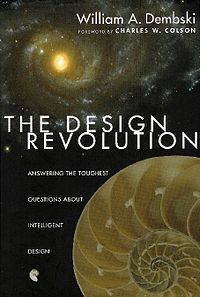The Design Revolution
 Cover | |
| Author | William A. Dembski |
|---|---|
| Language | English |
| Subject | Intelligent design |
| Publisher | InterVarsity Press |
Publication date | 2004 |
| Publication place | United States |
| Media type | |
| Pages | 334 |
| ISBN | 0-8308-3216-5 |
| OCLC | 123119351 |
| Preceded by | No Free Lunch: Why Specified Complexity Cannot Be Purchased without Intelligence |
| Followed by | Intelligent Design: The Bridge Between Science and Theology |
The Design Revolution: Answering the Toughest Questions about Intelligent Design is a 2004 book by William A. Dembski, who supports intelligent design, and the idea that certain features of the universe and of living things are best explained by an intelligent cause, not a naturalistic process such as natural selection. The book is written in question/answer format from Dembski's point of view as one of the conceptual leaders in the movement. Each chapter is about 4 pages long and addresses one specific question. Dembski describes these questions as from his prior ten years experience in lectures, media interviews, and published criticism by the scientific community[1] opposed to intelligent design, who constitute the majority of the scientific community and science education organizations.[2] The foreword was written by Charles W. Colson.
In the preface Dembski states he is progressively more convinced that Intelligent Design will revolutionize science, and that revolutionaries must be willing to take abuse and ridicule by the ruling elite, in this case the "dogmatic Darwinists and scientific naturalists."
Criticism
Mathematician Jeffrey Shallit criticises the book for evasion and dissembling. Mark Perakh mentions this book in his criticisms of Dembski, criticizing that the index does not contain the names of prominent critics.[3]
References
- ^ "The Design Revolution, Preface p 20".
- ^ See: 1) List of scientific societies rejecting intelligent design 2) Kitzmiller v. Dover page 83. The Discovery Institute's Dissent From Darwin Petition has been signed by about 500 scientists. The AAAS, the largest association of scientists in the U.S., has 120,000 members, and firmly rejects intelligent design and denies that there is a legitimate scientific controversy. More than 70,000 Australian scientists and educators condemn teaching of intelligent design in school science classes. List of statements from scientific professional organizations Archived 2008-03-28 at the Wayback Machine on the status intelligent design and other forms of creationism.
- ^ The design revolution? How William Dembski Is Dodging Questions About Intelligent Design, Mark Perakh, "We don't see in that index the following names: Rich Baldwin, Eli Chiprout, Taner Edis, Ellery Eels, Branden Fitelson, Philip Kitcher, Peter Milne, Massimo Pigliucci, Del Ratzsch, Jeff Shallit, Niall Shanks, Jordan H. Sobel, Jason Rosenhouse, Christopher Stephenson, Richard Wein, and Matt Young. All these writers have analyzed in detail Dembski's literary output and demonstrated multiple errors, fallacious concepts and inconsistencies which are a trademark of his prolific production."
